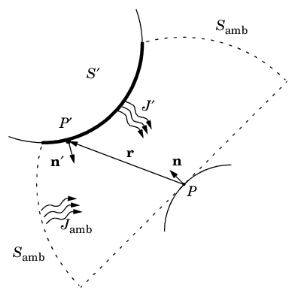The strategy for evaluating view factors is central to any radiation simulation. Loosely speaking, a view factor is a measure of how much influence the radiosity at a given part of the boundary has on the irradiation at some other part.
The quantities Gm and
Famb in
Equation 4-108 are not strictly view factors in the traditional sense. Instead,
Famb is the view factor of the ambient portion of the field of view, which is considered to be a single boundary with constant radiosity
On the other hand, Gm is the integral over all visible points of a differential view factor, multiplied by the radiosity of the corresponding source point. In the discrete model, think of it as the product of a view factor matrix and a radiosity vector. This is, however, not necessarily the way the calculation is performed.
Consider a point P on a surface as in
Figure 4-21. It can be seen by points on other surfaces such as
S′ in the figure, as well as the ambient surrounding,
Samb. Assume that the points on
S′ have a local radiosity,
J′, while the ambient surrounding has a constant temperature,
Tamb.

The mutual irradiation at point P is given by the following surface integral:
The heat flux that arrives from P′ depends on the local radiosity
J′ projected onto
P. The projection is computed using the normal vectors
n and
n′ along with the vector
r, which points from
P to
P′.
The ambient view factor, Famb, is determined from the integral of the surrounding surfaces
S′, here denoted as
F′:
The two last equations plug into Equation 4-107 to yield the final equation for irradiative flux.
where the integral over S⊥′ denotes the line integral along the boundaries of the 2D geometry.
A separate evaluation is performed for each unique point where Gm or
Famb is requested, typically for each quadrature point during solution. Differential view factors are normally computed only once, the first time they are needed, and then stored in memory until next time the model definition or the mesh is changed.
where θ is the angle between the normal to the irradiated surface and the direction of the source, and
r is the distance from the source. For a source at infinity, the view factor is given by
cos θ.
The zenith angle, θs, and azimuth angle,

, of the Sun are converted into a direction vector
is = (
isx,
isy,
isz) in Cartesian coordinates assuming that the north, the west, and the up directions correspond to the
x,
y, and
z directions, respectively, in the model. The relation between
θs,

, and
is is given by:
For an axisymmetric geometry, Gm and
Famb must be evaluated in a corresponding 3D geometry obtained by revolving the 2D boundaries around the axis. COMSOL Multiphysics creates this virtual 3D geometry by revolving the 2D boundary mesh into a 3D mesh. The resolution can be controlled in the azimuthal direction by setting the number of azimuthal sectors, which is the same as the number of elements to a full revolution. Try to balance this number against the mesh resolution in the
rz-plane. This number, the azimuthal sectors, is accessible from the Radiation Settings section in physics interfaces for heat transfer.
